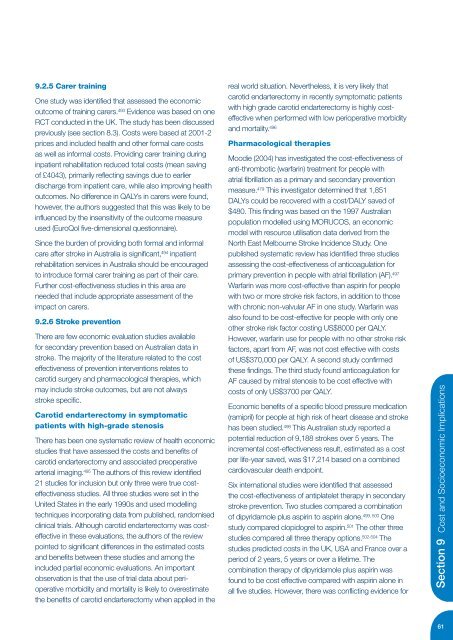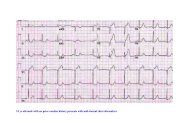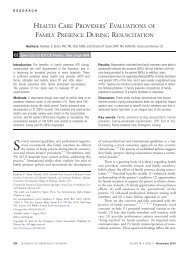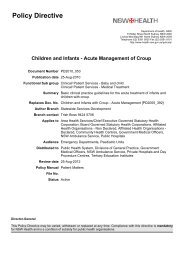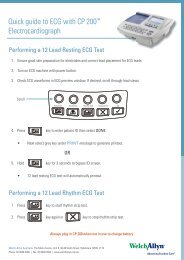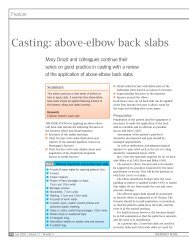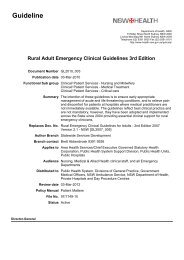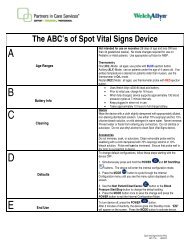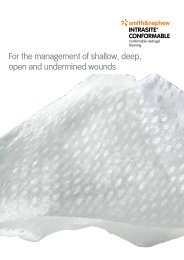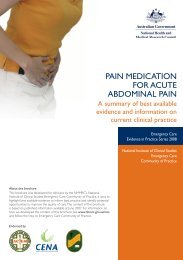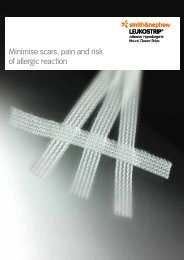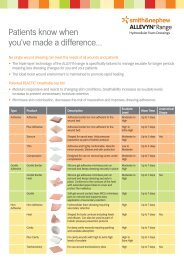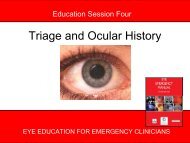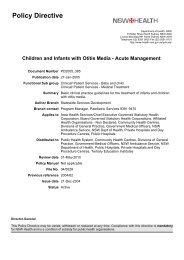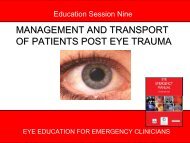Clinical Guidelines for Acute Stroke Management - Living on the EDge
Clinical Guidelines for Acute Stroke Management - Living on the EDge
Clinical Guidelines for Acute Stroke Management - Living on the EDge
You also want an ePaper? Increase the reach of your titles
YUMPU automatically turns print PDFs into web optimized ePapers that Google loves.
9.2.5 Carer training<br />
One study was identified that assessed <strong>the</strong> ec<strong>on</strong>omic<br />
outcome of training carers. 493 Evidence was based <strong>on</strong> <strong>on</strong>e<br />
RCT c<strong>on</strong>ducted in <strong>the</strong> UK. The study has been discussed<br />
previously (see secti<strong>on</strong> 8.3). Costs were based at 2001-2<br />
prices and included health and o<strong>the</strong>r <str<strong>on</strong>g>for</str<strong>on</strong>g>mal care costs<br />
as well as in<str<strong>on</strong>g>for</str<strong>on</strong>g>mal costs. Providing carer training during<br />
inpatient rehabilitati<strong>on</strong> reduced total costs (mean saving<br />
of £4043), primarily reflecting savings due to earlier<br />
discharge from inpatient care, while also improving health<br />
outcomes. No difference in QALYs in carers were found,<br />
however, <strong>the</strong> authors suggested that this was likely to be<br />
influenced by <strong>the</strong> insensitivity of <strong>the</strong> outcome measure<br />
used (EuroQol five-dimensi<strong>on</strong>al questi<strong>on</strong>naire).<br />
Since <strong>the</strong> burden of providing both <str<strong>on</strong>g>for</str<strong>on</strong>g>mal and in<str<strong>on</strong>g>for</str<strong>on</strong>g>mal<br />
care after stroke in Australia is significant, 494 inpatient<br />
rehabilitati<strong>on</strong> services in Australia should be encouraged<br />
to introduce <str<strong>on</strong>g>for</str<strong>on</strong>g>mal carer training as part of <strong>the</strong>ir care.<br />
Fur<strong>the</strong>r cost-effectiveness studies in this area are<br />
needed that include appropriate assessment of <strong>the</strong><br />
impact <strong>on</strong> carers.<br />
9.2.6 <str<strong>on</strong>g>Stroke</str<strong>on</strong>g> preventi<strong>on</strong><br />
There are few ec<strong>on</strong>omic evaluati<strong>on</strong> studies available<br />
<str<strong>on</strong>g>for</str<strong>on</strong>g> sec<strong>on</strong>dary preventi<strong>on</strong> based <strong>on</strong> Australian data in<br />
stroke. The majority of <strong>the</strong> literature related to <strong>the</strong> cost<br />
effectiveness of preventi<strong>on</strong> interventi<strong>on</strong>s relates to<br />
carotid surgery and pharmacological <strong>the</strong>rapies, which<br />
may include stroke outcomes, but are not always<br />
stroke specific.<br />
Carotid endarterectomy in symptomatic<br />
patients with high-grade stenosis<br />
There has been <strong>on</strong>e systematic review of health ec<strong>on</strong>omic<br />
studies that have assessed <strong>the</strong> costs and benefits of<br />
carotid endarterectomy and associated preoperative<br />
arterial imaging. 495 The authors of this review identified<br />
21 studies <str<strong>on</strong>g>for</str<strong>on</strong>g> inclusi<strong>on</strong> but <strong>on</strong>ly three were true costeffectiveness<br />
studies. All three studies were set in <strong>the</strong><br />
United States in <strong>the</strong> early 1990s and used modelling<br />
techniques incorporating data from published, randomised<br />
clinical trials. Although carotid endarterectomy was costeffective<br />
in <strong>the</strong>se evaluati<strong>on</strong>s, <strong>the</strong> authors of <strong>the</strong> review<br />
pointed to significant differences in <strong>the</strong> estimated costs<br />
and benefits between <strong>the</strong>se studies and am<strong>on</strong>g <strong>the</strong><br />
included partial ec<strong>on</strong>omic evaluati<strong>on</strong>s. An important<br />
observati<strong>on</strong> is that <strong>the</strong> use of trial data about perioperative<br />
morbidity and mortality is likely to overestimate<br />
<strong>the</strong> benefits of carotid endarterectomy when applied in <strong>the</strong><br />
real world situati<strong>on</strong>. Never<strong>the</strong>less, it is very likely that<br />
carotid endarterectomy in recently symptomatic patients<br />
with high grade carotid endarterectomy is highly costeffective<br />
when per<str<strong>on</strong>g>for</str<strong>on</strong>g>med with low perioperative morbidity<br />
and mortality. 496<br />
Pharmacological <strong>the</strong>rapies<br />
Moodie (2004) has investigated <strong>the</strong> cost-effectiveness of<br />
anti-thrombotic (warfarin) treatment <str<strong>on</strong>g>for</str<strong>on</strong>g> people with<br />
atrial fibrillati<strong>on</strong> as a primary and sec<strong>on</strong>dary preventi<strong>on</strong><br />
measure. 479 This investigator determined that 1,851<br />
DALYs could be recovered with a cost/DALY saved of<br />
$480. This finding was based <strong>on</strong> <strong>the</strong> 1997 Australian<br />
populati<strong>on</strong> modelled using MORUCOS, an ec<strong>on</strong>omic<br />
model with resource utilisati<strong>on</strong> data derived from <strong>the</strong><br />
North East Melbourne <str<strong>on</strong>g>Stroke</str<strong>on</strong>g> Incidence Study. One<br />
published systematic review has identified three studies<br />
assessing <strong>the</strong> cost-effectiveness of anticoagulati<strong>on</strong> <str<strong>on</strong>g>for</str<strong>on</strong>g><br />
primary preventi<strong>on</strong> in people with atrial fibrillati<strong>on</strong> (AF). 497<br />
Warfarin was more cost-effective than aspirin <str<strong>on</strong>g>for</str<strong>on</strong>g> people<br />
with two or more stroke risk factors, in additi<strong>on</strong> to those<br />
with chr<strong>on</strong>ic n<strong>on</strong>-valvular AF in <strong>on</strong>e study. Warfarin was<br />
also found to be cost-effective <str<strong>on</strong>g>for</str<strong>on</strong>g> people with <strong>on</strong>ly <strong>on</strong>e<br />
o<strong>the</strong>r stroke risk factor costing US$8000 per QALY.<br />
However, warfarin use <str<strong>on</strong>g>for</str<strong>on</strong>g> people with no o<strong>the</strong>r stroke risk<br />
factors, apart from AF, was not cost effective with costs<br />
of US$370,000 per QALY. A sec<strong>on</strong>d study c<strong>on</strong>firmed<br />
<strong>the</strong>se findings. The third study found anticoagulati<strong>on</strong> <str<strong>on</strong>g>for</str<strong>on</strong>g><br />
AF caused by mitral stenosis to be cost effective with<br />
costs of <strong>on</strong>ly US$3700 per QALY.<br />
Ec<strong>on</strong>omic benefits of a specific blood pressure medicati<strong>on</strong><br />
(ramipril) <str<strong>on</strong>g>for</str<strong>on</strong>g> people at high risk of heart disease and stroke<br />
has been studied. 498 This Australian study reported a<br />
potential reducti<strong>on</strong> of 9,188 strokes over 5 years. The<br />
incremental cost-effectiveness result, estimated as a cost<br />
per life-year saved, was $17,214 based <strong>on</strong> a combined<br />
cardiovascular death endpoint.<br />
Six internati<strong>on</strong>al studies were identified that assessed<br />
<strong>the</strong> cost-effectiveness of antiplatelet <strong>the</strong>rapy in sec<strong>on</strong>dary<br />
stroke preventi<strong>on</strong>. Two studies compared a combinati<strong>on</strong><br />
of dipyridamole plus aspirin to aspirin al<strong>on</strong>e. 499, 500 One<br />
study compared clopidogrel to aspirin. 501 The o<strong>the</strong>r three<br />
studies compared all three <strong>the</strong>rapy opti<strong>on</strong>s. 502-504 The<br />
studies predicted costs in <strong>the</strong> UK, USA and France over a<br />
period of 2 years, 5 years or over a lifetime. The<br />
combinati<strong>on</strong> <strong>the</strong>rapy of dipyridamole plus aspirin was<br />
found to be cost effective compared with aspirin al<strong>on</strong>e in<br />
all five studies. However, <strong>the</strong>re was c<strong>on</strong>flicting evidence <str<strong>on</strong>g>for</str<strong>on</strong>g><br />
Secti<strong>on</strong> 9 Cost and Socioec<strong>on</strong>omic Implicati<strong>on</strong>s<br />
61


